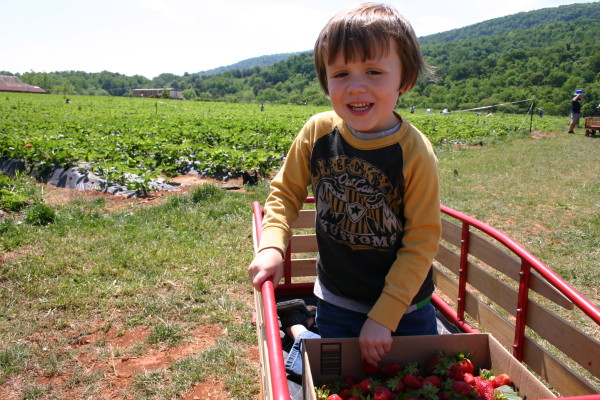There has been a lot of talk lately about the importance of buying locally (or within 100 miles of your home). The most popular reason for going local is that it saves energy and reduces the impact on the environment. A lot of resources go into shipping tomatoes from Mexico to Maine. According to a study of Midwestern markets, most produce has to travel 1,500 miles to market.
When you buy local produce, you buy riper produce because it doesn’t have to be shipped as far. Local foods are fresher and taste better. Farmers who grow produce with the intent to ship it usually choose varieties based on how long they can last, not as much on taste. And local produce usually has more nutrients because it is consumed closer to the time it is picked, before valuable nutrients have a chance to disappear.

When you purchase food or products made locally, you support your community, from the farmers who grow the food to the merchants who sell the food to the repair people who maintain the store. Every dollar that you spend will be circulated back through your community. However, when you buy from a major grocery or discount department store, most of your money goes to executives in other states, to packaging and advertising, or to China where most of their products are made.
Another reason I choose to focus on buying locally is for my family’s health. When you buy locally-made food, you get more information on how and where your food was grown. I know that the eggs I bought at the farmers’ market were laid by chickens that were allowed to roam free and were fed only organic and vegetarian food. I can have conversations with the farmers about whether pesticides were used on the apples I am buying and what kind were used.
I live in a fantastic community that has a strong emphasis on buying locally. The restaurants where I eat buy their produce from local farms, their ice cream from a local ice cream manufacturer and their bread from a local bakery. We have at least 5 different regular farmers’ markets each week, and they vendors are required to only sell locally-made goods. So it’s easy for me to buy locally-made products.
Things I do to go local:
- Every week, I take my family to the local farmers’ market to buy fruits and vegetables, free-range eggs, plants and soap. My son’s favorite parts of the market are the fresh strawberry popsicles and the face-painting station. Our city market is usually packed with people and we are always running into friends and neighbors. And it’s a great opportunity to teach kids where food comes from. To find farmers’ markets in your area, visit localharvest.org or eatwellguide.org.
- In addition to a stop at the local natural foods store, I always make sure to stop at the local bakery for fresh-baked all-natural bread and at the local butcher for organic, locally-raised meat.
- When a new season of produce begins, we make a trip to one of the pick-your-own farms and load up on fresh fruits and vegetables. We just went to pick our own strawberries, which I have used to make strawberry ice cream, strawberry freezer jam, and strawberry smoothies. I also used quart-sized Mason jars to freeze the rest of the strawberries so we would have them all year. Another alternative is to use Pyrex or Anchor glass bowls. I wouldn’t recommend plastic bowls or bags because plastic leaches harmful toxins, especially when frozen or heated (see discussion on Plastics).
- To supplement my trips to the farmers’ market and natural food stores, I also subscribe to a CSA share. CSA stands for Community Supported Agriculture. Through one of these programs, local farmers allow individuals to purchase shares in their products. In return, you will receive a box of vegetables and sometimes fruits. Some farms also offer things like eggs, milk, cheese and meat. Visit localharvest.org or eatwellguide.org for a CSA program near you.
- Visit local Arts & Crafts fairs to purchase gifts and jewelry.
- You can’t get any more local than your own backyard. Unfortunately, we are currently renting our home so my gardens are limited to large pots of herbs, tomatoes, blueberries, strawberries, blackberries, lettuce, broccoli and cauliflower. I get a surprising amount of food from these pots but not enough to feed my whole family for the season. In my last home, I constructed (with the help of my husband) three 4’x8′ raised bed gardens in addition to the pots. The benefit to a raised bed garden is that it is easier to supplement your soil with compost and rich garden soil and it keeps everything nicely contained. The best part about gardening at home is that I can get my son involved. He loves to help me plant seeds, and I can’t resist the smile on his face when he picks a fresh cucumber or tomato. I believe that raising him around a garden has cultivated his love of vegetables!
- Attend local concerts and events sponsored by local artists. Every weekend, local bands play at a small venue in our city. Rather than spend $30+ on a movie, we sit outside and listen to free live music. Visit festivalnet.com for events near you.
NOTICE: Blog posts on OnePartSunshine.com may contain affiliate links. In other words, if you buy something after clicking on a link in this post, then the author might receive an affiliate commission.
Want more One Part Sunshine? Here’s how:
- Follow us on Twitter
- Like us on Facebook
- Check us out on Pinterest
- Subscribe to our email newsletter
